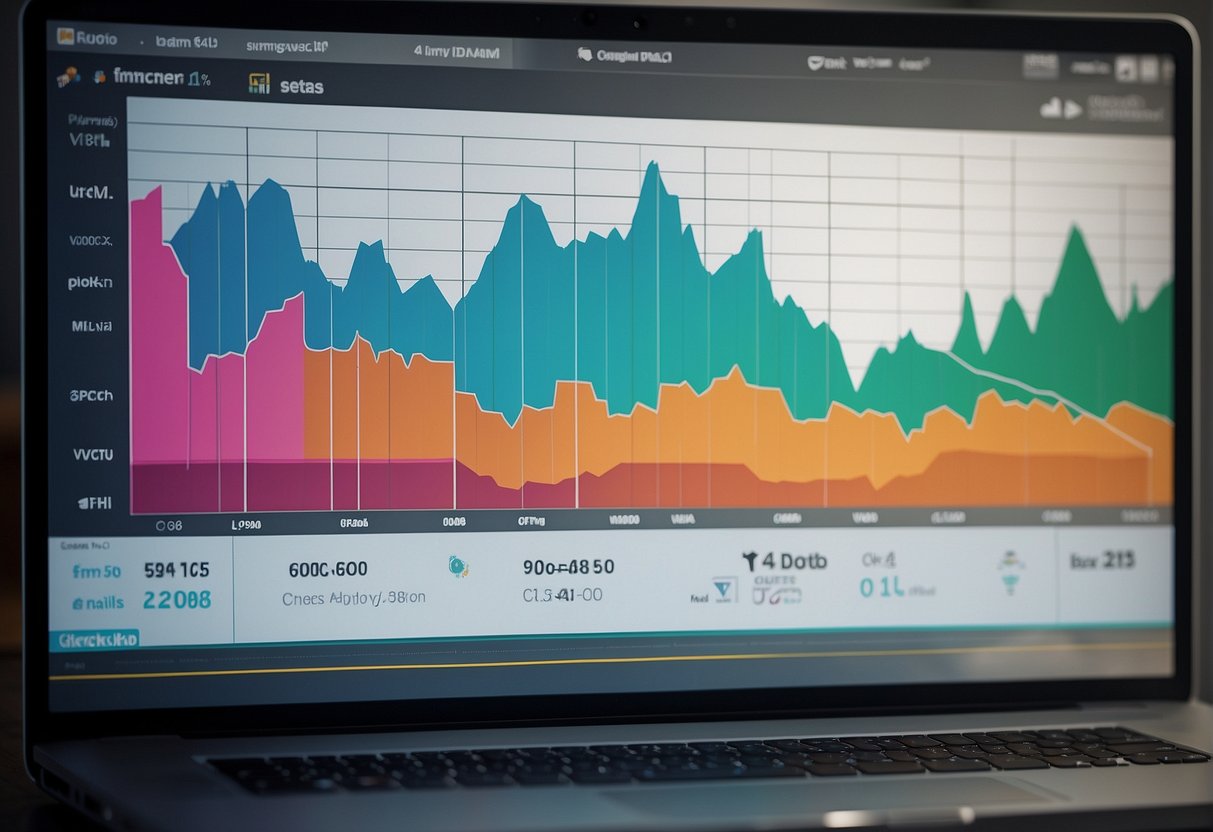Cryptocurrencies have become increasingly popular as an alternative form of investment, attracting casual investors and seasoned financial experts alike. However, one of the main characteristics of these digital assets is their high volatility. Market volatility refers to the frequent and significant price fluctuations experienced by digital assets like Bitcoin, Ethereum, and others, setting them apart from traditional financial markets.

Understanding the factors contributing to cryptocurrency volatility is crucial for investors who want to navigate the world of digital assets successfully. Some main drivers of cryptocurrency market volatility include regulatory changes, security concerns, and market sentiment. Additionally, the actions of large-scale investors or “whales” can have a significant impact on the market, often leading to drastic price swings.
As an investor, it’s essential to understand how market volatility affects the value of your cryptocurrency investments and develop an appropriate risk management strategy. By carefully weighing the risks and potential returns, one can better navigate the volatile landscape of the crypto market and capitalize on opportunities when they arise.
Key Takeaways
- Cryptocurrencies are known for their high volatility, with frequent and significant price fluctuations.
- Factors contributing to volatility include regulatory changes, security concerns, market sentiment, and the actions of large-scale investors.
- Understanding market volatility and its impact on investments is crucial for developing an appropriate risk management strategy.
Understanding Cryptocurrency Volatility
Defining Market Volatility
Market volatility refers to the degree of price fluctuations in any financial market, including stocks, bonds, commodities, and cryptocurrencies. In a volatile market, prices can change quickly, exposing investors to significant profit or loss potential. Typically, higher volatility comes with higher risk and can result in more substantial gains or losses for investors.
Crypto Volatility vs. Traditional Financial Markets
Cryptocurrencies exhibit more volatility compared to traditional financial markets. While traditional markets, such as stocks or bonds, can experience considerable fluctuations, the crypto market tends to have more significant price swings in both directions. Several factors contribute to this difference in volatility, such as lower market capitalization, market manipulation, and less regulatory oversight.
Factors Contributing to Crypto Volatility
- Market Capitalization: Crypto markets have a smaller market capitalization than traditional financial markets. This implies that even smaller trades can cause more significant price changes in cryptocurrencies than in other asset classes.
- Regulatory Environment: Cryptocurrencies operate in a less regulated space than traditional assets, and this lack of oversight can contribute to increased volatility. Unestablished frameworks and industry standards can lead to price uncertainty and speculative behavior.
- Market Manipulation: Market manipulation is more common in the crypto sector due to the lack of regulation. “Whale” investors who hold large amounts of a particular cryptocurrency can influence market prices by making substantial trades, leading to more volatility.
- Media and Public Perception: Media coverage and public perception play crucial roles in crypto volatility. News stories and market sentiment can drive prices up or down faster than in traditional markets. Positive or negative news can instantly impact the value of a cryptocurrency.
- Technological Developments: Blockchain technology’s rapidly evolving nature and applications can influence crypto prices. Breakthroughs, scaling solutions, or security concerns can cause price fluctuations as investors react to these changes.
These factors and numerous others contribute to the higher levels of market volatility seen in cryptocurrencies. Investors should be prepared for unexpected price movements when participating in this market. However, understanding the reasons behind these fluctuations can help investors make more informed decisions about their crypto investments.
Impact of Market Volatility on Cryptocurrency Investments
Effects on Asset Valuation
Market volatility plays a significant role in valuing cryptocurrencies as an investment asset. Due to the rapid price fluctuations that cryptocurrencies experience, their values can change drastically in a short period. The lack of stability might lead to increased uncertainty and difficulty in accurately valuing these digital assets. For instance, Bitcoin’s value has experienced dramatic price changes within a few days or weeks. It has led some investors to see cryptocurrencies as a highly speculative and risky asset class.
Influence on Investor Sentiment
Investor sentiment is another area heavily affected by market volatility in the cryptocurrency space. Rapid price changes can lead to emotional reactions, such as fear or greed, which might influence investment decisions. This has resulted in some market participants experiencing significant losses due to panic selling or making irrational investments during highly volatile periods. In contrast, others could profit from short-term trading strategies that exploit these fluctuations. According to a study from Open Economies Review, understanding the relationship between volatility and investor sentiment can provide essential insights for market participants, investors, and regulators.
Price Fluctuations and Investor Returns
Cryptocurrency investors need to be aware of the potential impact of market volatility on their returns. The returns on cryptocurrency investments depend on the asset’s price fluctuations and market conditions when buying and selling. As a result, the relationship between investment returns and volatility can be complex.
For example, consider the following scenarios:
- High volatility and positive price movement: An investor who buys low and sells high can reap significant returns.
- High volatility and negative price movement: An investor who buys high and sells low may incur substantial losses.
- Low volatility and steady price movement: An investor may experience lower returns, but the risk of losses could be minimized.
In conclusion, investors must carefully consider market volatility when investing in cryptocurrencies. It’s essential to evaluate their risk tolerance and investment objectives and keep track of the evolving market trends to successfully navigate this asset class’s volatile nature.
Risk Management in Volatile Crypto Markets
Portfolio Diversification
One of the critical methods to manage risk in the volatile crypto markets is portfolio diversification. This involves spreading investments across various cryptocurrencies instead of concentrating on a single asset. A well-diversified portfolio reduces the overall risk by mitigating the impact of a sudden price drop in a particular cryptocurrency.
Some ways to diversify a cryptocurrency portfolio include:
- Investing in various crypto assets: Allocate funds to different cryptocurrencies, such as Bitcoin, Ethereum, and other altcoins.
- Balancing between established and emerging projects: Mix investments between well-established cryptocurrencies and promising new projects to reduce risks associated with the unpredictable nature of the market.
- Diversifying across sectors: Invest in cryptocurrencies from different industries, such as finance, gaming, and technology, to minimize exposure to a specific sector’s fluctuations.
Hedging Strategies
Another approach to managing risk in cryptocurrency investments is employing hedging strategies. Hedging involves taking a position in one asset to offset potential losses in another. Some common hedging strategies utilized in the crypto market are:
- Futures and options: Trading cryptocurrency futures and options can help protect against adverse price movements. Investors can lock in a predetermined price for a cryptocurrency at a specified future date, thus reducing exposure to volatility.
- Stablecoins: These are cryptocurrencies pegged to a stable asset, such as fiat currencies or commodities. Using stablecoins in a portfolio can provide a cushion against extreme price swings in other cryptocurrencies.
- Asset allocation: Allocating a portion of the investment portfolio to traditional assets, such as stocks, bonds, and commodities, can help offset potential losses in the crypto market.
Understanding Risk Tolerance
Investors must understand their risk tolerance before venturing into the volatile crypto markets. Risk tolerance refers to an individual’s willingness to accept the possibility of losses in pursuit of potential rewards.
Investors can assess risk tolerance by considering investment goals, financial situation, and time horizon. Once this is established, they can design an investment strategy that aligns with their risk appetite. This may include selecting suitable cryptocurrencies, appropriate diversification methods, and the size of the investment relative to the overall portfolio.
In conclusion, managing risk in the volatile crypto market is essential for long-term success. A combination of portfolio diversification, hedging strategies, and understanding one’s risk tolerance can help investors navigate market fluctuations more effectively.
Cryptocurrency Markets and Global Events
Effects of Geopolitical Uncertainty
Geopolitical uncertainty often triggers market volatility in financial markets, including cryptocurrency. World events like trade wars, political tensions, and natural disasters can create uncertainty among investors. As a result, the demand for cryptocurrencies may increase or decrease, leading to significant price fluctuations. For example, during the US-China trade war, the crypto market experienced increased volatility as investors sought alternative investments.
Impact of Regulatory Changes
Regulatory changes can also affect the volatility of cryptocurrency markets. Regulation changes, such as introducing new taxes or restrictions on cryptocurrency trading, can have short-term and long-term effects on market stability. In some cases, regulatory changes can result in a reduction in market volatility. However, in other cases, regulation changes can increase uncertainty and cause the opposite effect.
Examples of regulatory impacts on cryptocurrencies include:
- Tighter regulations: When governments introduce stricter regulations on cryptocurrencies, it creates uncertainty among investors and may lead to market sell-offs and increased volatility.
- Loosening of regulations: When governments relax regulations or provide more clarity, it can boost investor confidence and stabilize the market.
- Global regulatory changes: Important regulatory decisions from one country can also have ripple effects in other jurisdictions, leading to more significant price fluctuations in the worldwide crypto market.
Economic Indicators and Crypto Markets
Traditional economic indicators can also have an impact on cryptocurrency markets. Economic indicators such as interest rates, inflation, and economic growth can influence investor sentiment, leading to market fluctuations in the crypto market. For instance, when major central banks make decisions on interest rates, this can lead to changes in the valuation of cryptocurrencies.
Some common economic indicators that may affect cryptocurrency prices are:
- Interest rates: Lower interest rates may encourage risk-taking, leading to more cryptocurrency investments and vice versa.
- Inflation: High inflation can erode the value of traditional currencies, pushing investors towards alternative investments like cryptocurrencies.
- Economic growth: Strong economic growth can boost investor confidence, leading to increased investment in risky assets, including cryptocurrencies.
In conclusion, the cryptocurrency market is influenced by various global events and economic indicators. Understanding the effects of geopolitical uncertainty, regulatory changes, and economic indicators can help investors navigate cryptocurrencies’ dynamic and often volatile world.
Investment Strategies for Handling Volatility
Long-Term vs Short-Term Investing
When dealing with market volatility, it’s crucial to differentiate between long-term and short-term investing. Long-term investors typically have a time horizon of several years or even decades, allowing them to ride out market fluctuations without panicking during short-term dips. By utilizing diversification strategies within their cryptocurrency portfolio, they can mitigate risk and minimize the impact of market volatility on their investments.
On the other hand, short-term investors may operate on days, weeks, or months and tend to react more quickly to market changes. Short-term traders should be prepared to actively manage their investments, using tools such as stop-loss orders to protect their capital during volatile periods. Staying informed and regularly reviewing your altcoin portfolios is essential for intelligent decision-making.
Speculation and Market Timing
Market timing and speculation are often employed in volatile markets but come with risks. Speculators may seek to capitalize on price fluctuations by buying low and selling high, which can be challenging to predict and execute consistently. Attempting to time the market also exposes investors to the risk of missing opportunities for long-term growth.
Instead of relying solely on speculation and market timing, consider adopting a balanced approach between long-term and short-term strategies. This could include setting specific investment goals, diversifying your portfolio, and employing a risk-management strategy that accounts for long-term and short-term growth opportunities.
Liquidity Considerations
Another factor to consider when investing in cryptocurrencies is liquidity. Liquidity is the ease with which an asset can be bought or sold without significantly impacting its price. In times of market volatility, liquidity can become a crucial factor affecting the success of your investment strategy.
Consider liquidity when selecting cryptocurrencies, as coins with lower trading volumes may be more susceptible to price manipulation or large price swings. You can also use advanced options like Bumper or other risk management tools to safeguard your investments during volatile periods.
By understanding the different factors affecting cryptocurrency investments, such as market volatility, investment horizons, and liquidity, you can develop a tailored investment strategy to navigate the ever-changing landscape of cryptocurrency markets. Remember that a well-rounded strategy should include a mix of long-term and short-term approaches, focusing on diversification and risk management.
Psychology of Investing in Volatile Markets
Market Hype and Emotional Trading
Market hype significantly affects investors’ decision-making processes, especially in cryptocurrency investments. Emotional trading often results from exaggerated claims and speculative stories circulating in the media. This can cause investors to act impulsively out of fear or greed, leading to poorly timed trades and potential losses. A study conducted by Morningstar emphasizes the importance of understanding core behavioral principles to make better decisions during volatile market conditions.
In the cryptocurrency market, hype is commonly associated with social media and news articles that can create a sense of urgency among investors. This has been evident in various market events, most notably the meteoric rise and subsequent crash of Bitcoin in 2017 and 2018.
Behavioral Biases and Decision-Making
Investor psychology plays a vital role in decision-making during periods of market volatility. Among the most common behavioral biases are:
- Herd Mentality: Many investors tend to follow the crowd in trading decisions, often leading to asset bubbles and crashes. Herd mentality sometimes results from a fear of missing out on an investment opportunity, causing investors to buy or sell assets based on the actions of others rather than independent analysis. This phenomenon is discussed in detail in this article.
- Overconfidence: Overconfident investors may overestimate their ability to predict market movements and tend to trade more frequently, which can result in lower returns. Overconfidence can also make traders less receptive to new information, leading to poor decision-making.
- Loss Aversion: Investors often display a more robust emotional response to potential losses than gains, leading to the well-known disposition effect, where they hold on to losing investments for too long and sell winning investments too soon.
- Confirmation Bias: Investors with confirmation bias search for and interpret information in a way that supports their preconceived opinions, often overlooking contradictory facts or opinions.
Investors must maintain a disciplined approach and stick to a predefined investment strategy to mitigate these biases. By doing so, investors can potentially minimize the impact of emotional trading and maintain a more rational perspective during periods of increased market volatility.
Analyzing the Crypto Market’s Historical Volatility

Market Value Trends
The crypto market has experienced significant fluctuations in its relatively short histpredefineditcoin’s infamous rise to its all-time high in December 2017 to the “crypto winter” that followed, and various factors continue to impact market value trends. One major contributor to these fluctuations is the market sentiment and perception of historical volatility affecting the price of cryptos.
To better understand these trends, let’s take a look at some relevant data:
- 2013 – Bitcoin experienced a 3,624% increase in price, followed by a 58% drop the following year.
- 2017 – Bitcoin reached its all-time high of nearly $20,000, only to lose about 80% of its value in 2018.
- 2021 – Bitcoin made another impressive surge, reaching an all-time high of over $68,000 before experiencing a significant decline again.
These market value trends showcase the extreme price movements that cryptocurrencies can exhibit.
Volatility Spillovers Between Assets
The volatility spillovers between different cryptocurrencies are another fascinating aspect of the market. It refers to the transmission of volatilities from one asset to another, which can reshape the crypto market dynamics.
A few key findings regarding spillovers in cryptocurrency markets include:
- Major Cryptocurrencies – Assets like Bitcoin and Ethereum significantly influence the crypto market, driving price movements and market sentiment across multiple assets.
- Minor Cryptocurrencies – Surprisingly, minor cryptocurrencies also impact the market, sharing similar transaction activities and affecting investment decisions.
These volatility spillovers demonstrate the interconnected nature of cryptocurrency investing and provide insight into how the performance of individual assets can impact the larger market.
By examining both market value trends and volatility spillovers, investors can gain a deeper understanding of how historical volatility has shaped the crypto market landscape, enabling them to make more informed decisions and carefully navigate periods of market uncertainty.
The Role of Institutional Investors in Crypto Volatility

In recent years, institutional investors have increasingly shown interest in cryptocurrency. Their involvement has both positive and negative implications for crypto volatility. This section will explore two critical factors institutional investors influence: market liquidity and the differences between institutional and retail traders.
Market Liquidity and Large Orders
Institutional investors, which include pension funds, hedge funds, and high-frequency traders, can execute large orders in the market. These sizable transactions have the potential to affect market price and volatility drastically. When institutional investors make large purchases or sales, the impact on the market can be significant due to the immediate effect on liquidity.
However, in the long run, increased participation of institutional investors reduces volatility by providing more liquidity to the market. This increased liquidity is beneficial for the overall stability of the crypto market, as it enables more fluid trading and a reduction in price fluctuations.
Institutional Investors vs. Retail Traders
Institutional investors and retail traders differ in their approach to the market. Retail traders typically have smaller capital and trade in smaller volumes. They are more likely to be influenced by emotions and make decisions based on short-term market trends. On the other hand, institutional investors have access to a wide range of resources and are primarily concerned with long-term strategies and market fundamentals.
As a result, the presence of institutional investors in the crypto market can contribute to reduced volatility by offsetting the emotional trading of retail investors. Their longer investment horizons make institutional investors less likely to react to short-term market fluctuations, further stabilizing market conditions.
In conclusion, the involvement of institutional investors in the crypto market has both positive and negative implications for market volatility. While their large orders can cause liquidity to shift quickly, ultimately, their presence contributes to a more stable and mature market by providing increased market liquidity in the long run and counterbalancing retail traders’ emotional trading patterns.
Interdependence of Bitcoin and Altcoins

Correlation Between Bitcoin and Other Cryptocurrencies
Over the years, there has been a noticeable correlation between Bitcoin and other cryptocurrencies regarding price movement. This means that when the value of Bitcoin increases, it often prompts a similar reaction in the prices of other altcoins. This correlation can result from factors such as investor sentiment, the technological advancements within the industry, and the increasing acceptance of cryptocurrencies.
However, it is essential to note that the degree of correlation between Bitcoin and altcoins can vary. For example, newer and less established cryptocurrencies might not have a close relationship with the pioneer digital asset. Investors looking for diversification within the cryptocurrency market should be aware of these variations.
Market Shocks and Altcoin Reactions
Market shocks, such as regulatory changes or significant events like the COVID-19 outbreak, can significantly affect the volatility of cryptocurrencies. When these events occur, Bitcoin’s price can see drastic changes, and due to the interdependence between Bitcoin and altcoins, it often leads to a ripple effect in the prices of other digital assets.
In market shock, altcoins can experience more substantial reactions than Bitcoin. This can largely be attributed to their smaller market capitalization and lower liquidity levels, which make them more susceptible to market fluctuations. In some cases, the subsequent impact on the altcoin market could result in investors pouring their money into Bitcoin in search of a safer option.
Overall, understanding the interdependence of Bitcoin and altcoin and how they react to market shock is crucial for investors looking to navigate the cryptocurrency market’s volatility. It helps assess the potential risks and opportunities associated with different digital assets and ultimately enables more informed decision-making.
Comparing Crypto to Other Investment Classes

Crypto vs. Stocks
Cryptocurrencies and stocks are two distinct investment classes with different properties. Stocks represent company ownership, whereas cryptocurrencies represent digital assets based on cryptographic technology. Investors looking to diversify their portfolios should understand the differences between them.
- Volatility: Both stocks and cryptocurrencies experience market fluctuations, but crypto assets tend to be more volatile due to their relatively young market and lesser liquidity. Stocks demonstrate lower volatility and can be affected by specific company issues and market sentiment.
- Liquidity: Stocks are generally more liquid, as they’re traded in centralized markets with high liquidity. In some scenarios, crypto assets can suffer from low liquidity, which might hinder their availability.
- Regulation: Stock markets are highly regulated, protecting investors through robust compliance policies. Crypto markets, by comparison, are still developing regulatory frameworks, posing a higher level of uncertainty for investors.
- Dividends: Some stocks offer regular dividends to shareholders as passive income. Crypto assets, on the other hand, typically don’t provide dividends, except for some instances, such as staking or decentralized finance (DeFi) platforms.
Crypto vs. Commodities
Commodities such as gold, silver, and oil have long been prevalent investment options. Comparing them with cryptocurrencies can help investors decide the right mix of assets for their portfolios.
- Store of Value: Physical commodities, particularly gold, have historically been considered a store of value, maintaining their purchasing power over time. In contrast, the store of value property of cryptocurrencies, like Bitcoin, is still debated, given their relatively short history and high volatility.
- Volatility: Commodities have lower price volatility compared to cryptocurrencies. While both may experience price fluctuations due to external factors, such as economic and geopolitical events, cryptocurrencies exhibit more significant price swings.
- Usability: Some commodities have industrial use cases, such as gold and silver, affecting demand and value. Conversely, cryptocurrencies serve as digital assets with distinct use cases like decentralized finance, smart contracts, and digital payments.
- Accessibility: Cryptocurrencies are easily accessible through various digital platforms. Commodities, in contrast, often require specialized accounts or even physical storage to hold and trade.
Recognizing the differences between crypto assets and traditional investment classes like stocks and commodities can help investors make informed decisions on portfolio allocation, balancing risk and rewards.
Evolution of Cryptocurrency Trading Practices

Margin Trading and Leverage
Margin trading has become widespread in cryptocurrency markets, allowing investors to trade more significant amounts with a smaller initial capital. By borrowing funds from a broker or an exchange, traders can open positions significantly more influential than their account balance. This is known as leverage, which means increasing the potential gains from a trade and the potential losses.
For example, if a trader uses a 10x leverage, they can trade $10,000 worth of cryptocurrency with just $1,000 in their account. While this can lead to more significant profits, it also risks substantial losses if the market moves against the trader’s position. Consequently, margin trading requires a more advanced understanding of market dynamics and a sound risk management strategy.
Algorithmic Trading and AI
The rapid development of technology has enabled the rise of algorithmic trading and artificial intelligence (AI) in the cryptocurrency market. These automated trading systems utilize sophisticated algorithms and machine learning models to analyze market data, identify patterns, and execute trades based on predefined criteria. Algorithmic tradinpredefinedate much faster than human traders and helps mitigate the impact of human emotions on trading decisions.
Common algorithmic trading strategies include arbitrage, market making, and trend following. Arbitrage involves capitalizing on price differences between different exchanges or markepredefined making, which is the strategy of providing liquidity by placing both buy and sell orders to profit from the bid-ask spread. The trend-following strategy aims to capitalize on market trends by taking long or short positions in response to technical signals.
As AI technologies advance, applying these techniques in cryptocurrency trading will become more sophisticated and provide even better market insights. This evolution will likely lead to greater efficiency and liquidity in cryptocurrency markets, benefiting traders and investors.
Measuring the Financial Impact of Crypto Volatility

Assessing Investment Loss and Gain
Just like with any other financial asset, cryptocurrency volatility can lead to both gains and losses for investors. High volatility means that the prices of cryptocurrencies can change rapidly, causing significant changes in the value of an investor’s portfolio. To understand the financial impact, it’s essential to analyze both the potential for profits and the risk of losses.
Investors can evaluate the performance of their cryptocurrency investments by calculating their percentage returns. This is done by dividing the investment’s gain or loss by the initial capital invested. For example, if an investor bought a Bitcoin worth $10,000 and sold it for $12,000, their return would be 20% (($12,000 – $10,000) / $10,000 * 100).
It’s also crucial to monitor the value of cryptocurrency investments over time. Investors can benefit from diversification by allocating their funds across different cryptocurrencies. This helps to mitigate the risk associated with highly volatile individual assets, like Bitcoin, Ethereum, or other altcoins.
Impact on the Broader Financial System
Crypto volatility can have repercussions on the broader financial markets as well. Many institutional investors, such as hedge funds and asset management firms, have started to include cryptocurrencies in their portfolios. This means that the volatility of these digital assets can influence the performance of the larger financial market to some extent.
For example, a sudden drop in the value of cryptocurrencies may cause investors to pull out funds from traditional stock markets. This can lead to a sell-off in the stock market and a subsequent decline in stock prices. Conversely, substantial gains in the cryptocurrency market can encourage more investors to participate, seeking potentially higher returns.
Additionally, regulatory changes and announcements can affect the cryptocurrency market’s volatility. Research has shown that price volatility, liquidity volatility, and return volatility in the cryptocurrency market increased significantly following regulatory announcements by policymakers. It is essential, therefore, for investors to stay informed about such developments and adjust their investment strategies accordingly.
In summary, the financial impact of crypto volatility extends to individual investors and the broader financial system. Assessing investment loss and gain, monitoring investment values over time, and understanding the influences on market volatility can help investors make informed decisions and mitigate risks.
Supply and Demand Dynamics in Cryptocurrency

Mining and Crypto Supply
The supply of cryptocurrencies depends mainly on their mining process. Mining is the technique of confirming transactions and adding new blocks to a blockchain ledger. Miners facilitate transactions using specific algorithms, and in return, they are rewarded with a certain amount of cryptocurrency. Some factors influencing the crypto supply include:
- Algorithm: Some cryptocurrencies use Proof of Work (PoW) algorithms, while others use Proof of Stake (PoS) or consensus mechanisms. Each algorithm type has unique characteristics that impact the supply rate.
- Block reward miners receive for adding a new block to the network. The reward size can affect the pace of mining activities and overall supply.
- Mining difficulty: The challenge of solving complex mathematical problems to add a new block to the blockchain affects the speed at which new coins enter the market.
- Halving events: For some cryptocurrencies, such as Bitcoin, the block reward gets cut in half periodically, reducing the rate of new coin generation and impacting supply.
Market Demand and Adoption Rates
The demand for cryptocurrencies largely depends on their adoption rates by various market participants. A higher demand for a particular cryptocurrency usually drives its price up, while a lower demand decreases the value. Several factors may influence market demand and adoption rates:
- Public awareness: The more people know a cryptocurrency and understand its potential benefits, the higher the likelihood of its demand and adoption.
- Utility and use cases: If a cryptocurrency offers unique solutions to real-world problems, such as improving cross-border transactions or intelligent contract management, this can significantly boost its demand.
- Regulatory environment: Government regulations and legal frameworks directly impact the acceptance and adoption of cryptocurrencies. Favorable regulations encourage investment, while strict regulations may deter market participants.
- Market sentiment: News events, expert opinions, and public perception can affect overall market sentiment and influence demand for cryptocurrencies.
In conclusion, understanding the supply and demand dynamics in the cryptocurrency market is essential for making well-informed investment decisions. Factors such as mining processes, adoption rates, and market sentiment can directly impact the volatility and value of cryptocurrencies over time.
Preparing for Future Volatility in Cryptocurrency Markets
Anticipating Market Movements
In cryptocurrency markets, price volatility is often considered both a risk and an opportunity for investors. One key aspect of preparing for future market fluctuations is understanding the factors that drive volatility. These may include regulatory changes, technological advancements, and market sentiment.
A crucial strategy for investors is regularly monitoring news and developments in the crypto space. For example,introducingf Bitcoin futures created a significant market impact, altering the cryptocurrency market dynamics. By staying informed, investors can better anticipate potential shifts and position themselves to benefit from market trends.
Adapting to Cryptocurrency Trends
Adapting to cryptocurrency trends is an essential aspect of navigating the volatile nature of the market. Some approaches investors may consider include:
- Diversification: Just like any other investment, diversification in the cryptocurrency space can help mitigate risk. By holding a mix of different cryptocurrencies, investors can better protect themselves against sharp price declines in a single asset.
- Risk management: A clear risk management strategy is vital for market volatility. This may involve setting stop-loss orders to sell holdings when a price threshold is reached automatically or employing dollar-cost averaging to invest a fixed amount on a regular schedule, regardless of price fluctuations . Example: If an investor plans to invest $1,000 in Bitcoin, they may choose to invest $100 per month for ten months rather than commit the total amount at once.
- Consider alternative investments: Other than investing directly in cryptocurrencies, investors can explore alternative investment options tied to the crypto market, such as blockchain-focused stocks or exchange-traded funds (ETFs).
- Staying informed: As mentioned earlier, keeping up-to-date with the latest trends and developments is crucial for anticipating market movements and making well-informed decisions.
Cryptocurrency markets are not immune to future price volatility, as recent evidence confirms the inherently unpredictable nature of these assets. By anticipating market movements and adapting to cryptocurrency trends, investors can be better prepared to navigate the challenges and opportunities presented by future volatility.
Frequently Asked Questions
What factors contribute to the high volatility of cryptocurrencies?
Cryptocurrencies experience high volatility due to several factors, such as market speculation, regulatory news, and technological advancements. The lack of institutional influence and market manipulation also contribute to the price fluctuations of digital assets—the Twists and Turns of Crypto Volatility Explained.
How can investors mitigate the effects of cryptocurrency volatility?
Investors can mitigate the effects of cryptocurrency volatility by employing strategies such as diversification, setting stop-loss orders, and conducting regular risk assessments. Mastering Market Volatility: Essential Insights for Cryptocurrency. Investors must stay informed, track market trends, and adjust their investment strategies accordingly.
In what ways does cryptocurrency volatility differ from stock market fluctuations?
Cryptocurrency volatility differs from stock market fluctuations as it tends to be more extreme due to the decentralized nature of digital assets and unmatched price movements. Additionally, cryptocurrencies lack the established regulatory frameworks and formalized investor protection mechanisms in traditional financial markets. I am explaining Crypto’s Volatility – Forbes.
What does heightened volatility in the crypto market indicate for traders?
Heightened volatility in the crypto market can indicate potential profit opportunities for traders and increased risks. By leveraging market analytics and technical indicators, traders can capitalize on price fluctuations and make well-informed decisions Market Volatility: Why Is Crypto So Volatile?.
How does overall market sentiment impact the volatility of cryptocurrencies?
Market sentiment plays a significant role in the volatility of cryptocurrencies. Positive sentiment, driven by widespread adoption or technological advancements, can increase buying pressure, increasing prices. Conversely, negative sentiment, such as regulatory concerns or security breaches, can lead to selling pressure and decreased prices. Volatility: What It Means In Crypto Markets.
Can tools or strategies help predict volatility trends in cryptocurrency markets?
Yes, various tools and strategies can assist in predicting volatility trends in cryptocurrency markets. Traders can employ technical analysis, utilization of volatility indexes, and sentiment analysis to anticipate price fluctuations and potential risks. Additionally, keeping a close eye on news, emerging technologies, and regulations can provide valuable insights for predicting market trends. Volatility: What It Means In Crypto Markets.
Conclusion
In summary, market volatility has a significant impact on cryptocurrency investments. These digital assets are known for their high fluctuations in value and can provide both opportunities and risks for investors.
Investors who thrive in volatile markets may find cryptocurrencies appealing due to their potential to offer high returns at a faster pace. However, this comes with the understanding that these investments can also experience sharp declines in value, leading to potential losses. It is essential for investors to be aware of the factors driving the volatility within the cryptocurrency market and to keep their risk tolerance in mind when allocating funds to these assets.
There has been an increasing interconnectedness among cryptocurrencies through their shared market behaviors, such as volatility spillovers and similar transaction activities. These connections can be observed in minor cryptocurrencies exerting significant influence on the overall market. This interconnectedness can further influence individuals’ investment strategies to limit exposure to specific, volatile assets.
While highly volatile, cryptocurrency investments offer investors the possibility of diversification within their portfolios. With many digital assets available, ranging from established options like Bitcoin to emerging altcoins, investors can navigate this new class of financial assets with varying levels of risk and reward.
In conclusion, understanding the inherent volatility of the cryptocurrency market is crucial for investors looking to participate in this rapidly evolving investment landscape. Market volatility can provide opportunities and challenges. However, embracing a well-informed approach, assessing risks, and staying abreast of market developments will be vital in shaping a successful investment strategy in cryptocurrencies.




